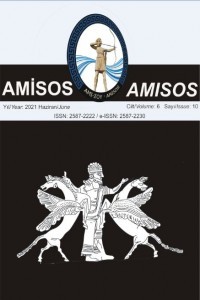SAVATRA VE ÇEVRESİNDE BULUNAN SÜTUN BAŞLIKLARI
Öz
Günümüz Konya-Aksaray karayolu üzerinde Yağlıbayat Mahallesi’nde yer alan Savatra Antik Kenti içerisinde yapılan kazılar ve çevresinde yapılan araştırmalar sonucunda ele geçen altı adet sütun başlığı ve sütun başlığı parçası bu çalışmada yer almaktadır. Çalışmada yer alan sütun başlıkları, Dorik-İonik ve İon başlıkları tanımlamasıyla iki farklı grup olarak ele alınmıştır. Sütun başlıklarının üretim ve bezeme dekorasyonu incelenerek Savatra Antik Kenti ve çevresinde dönem mimarisi hakkında bilgi edinilmiştir. Başlıkların ekinusu üzerinde yer alan ion kymathionu, başlıktan sütuna geçişinde kullanılan bezemeler, polster, polster alnı ve balteus alanları incelendiğinde, Dorik-İonik özellikli sütun başlığının M.S. I. yüzyılda üretilen başlıklar ile benzer özelliklere sahip olduğu görülmektedir. İon başlıkları ise ayrı bir şekilde incelenmiş, İon kymathionu, polster ve balteus alanlarında zengin bezeme ve ince işçiliğe sahip oldukları belirlenmiştir. Anadolu’da yer alan benzer üslupta ve benzer formda üretilen İon sütun başlıkları göz önünde bulundurularak, Savatra Antik Kenti ve çevresinde tespit edilen İon sütun başlıklarının genellikle M.S. II.-III. yüzyılda üretilen sütun başlıklarıyla benzer özellikler yansıttığı söylenebilir. Çalışmada yer verdiğimiz başlıkların tamamının devşirme malzeme olmasından dolayı hangi yapının taşıyıcı unsuru olarak kullanıldığı tespit edilememiştir. Çalışmada ele almış olduğumuz sütun başlıkları genel anlamda Roma Dönemi’ne ait mimari özellikleri yansıtmaktadır.
Abstract
Six column capitals and column capital fragments that were found as a result of the excavations made in the Savatra Ancient City located in the Yaglibayat District on the present-day Konya-Aksaray highway and the researches carried out in its surroundings are included in this study. Column capitals in the study were handled as two different groups with the definition of Doric-Ionic and Ionic capitals. By examining the production and embellishment decoration of the column capitals, information was obtained about the period architecture in and around the Ancient City of Savatra. When the Ionic kymathion on the equinus of the capitals, the decorations used in the transition from the capital to the column, the polster, polster forehead and balteus areas are examined, it has been seen that the Doric-Ionic feature column head has similar features with the column capitals produced in the 1st century A.D. Ionic capitals were examined separately and it was determined that they had rich embellishment decoration and fine workmanship in the Ionic kymation, polster and balteus areas. Considering the Ionic column capitals produced in similar style and form in Anatolia, it can be said that the Ionic column capitals found in the Savatra Ancient City and its surroundings generally reflect similar characteristics with the column capitals produced in the 2nd -3rd century A.D. Since all of the column capitals we included in the study were spolia, it could not be determined which structure was used as a carrier element. The column capitals that we have discussed in the study generally reflect the architectural features of the Roman Period.
Anahtar Kelimeler:
İon Başlıkları, Lycaonia, Roma Mimarisi, Savatra, Mimari Bezeme, Ionic Heads, Roman Architecture, Architectural Ornament
___
- Alp, O. 2006, Pisidia Bölgesi Roma Dönemi Bezemeli Mimari Elemanları, Ankara Üniversitesi, Sosyal Bilimler Enstitüsü, Klasik Arkeoloji Anabilim Dalı (Yayınlanmamış Doktora Tezi), Ankara.
- Aulock, V. H. 1976, “Münzen und Stadte Lykaoniens”, Istanbuler Mitteilungen, Beiheft 16. Deutsches Archaologisches Institut Abteilung İstanbul, Tübingen.
- Aybek, S. - Arslan, B. 2015, “Metropolis’te Bulunan M.S. 2.-3. Yüzyıla Tarihli İon Tipi Sütun Başlıkları”, (Eds. E. Okan – C. Atilla), Prof. Dr. Ömer Özyiğit’e Armağan, Ege Yayınları, İstanbul, 29-45.
- ISSN: 2587-2222
- Yayın Aralığı: Yılda 2 Sayı
- Başlangıç: 2016
- Yayıncı: Davut YİĞİTPAŞA
